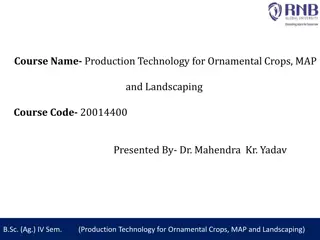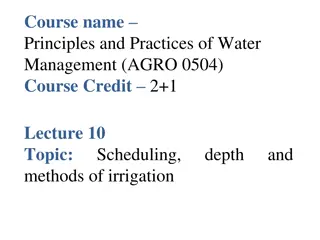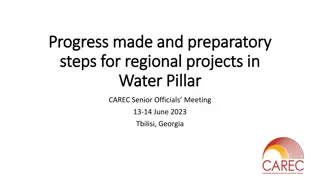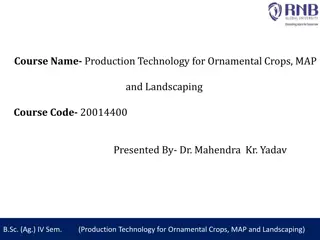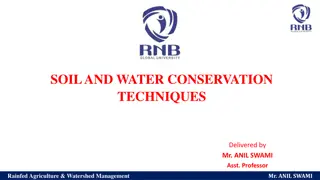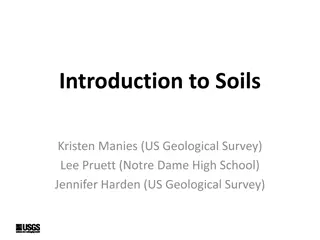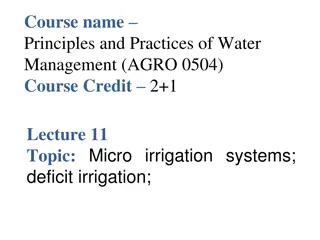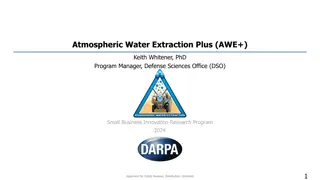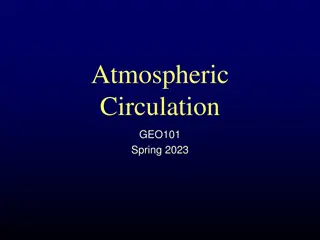Understanding Water Needs of Crops Based on Soil, Plant, and Climate Factors
How soil, plant, and meteorological elements impact water requirements of crops. Dive into the effects of temperature, solar radiation, pressure, wind, and humidity on crop production and growth.
Download Presentation
Please find below an Image/Link to download the presentation.
The content on the website is provided AS IS for your information and personal use only. It may not be sold, licensed, or shared on other websites without obtaining consent from the author. Download presentation by click this link. If you encounter any issues during the download, it is possible that the publisher has removed the file from their server.
Presentation Transcript
Course name Principles and Practices of Water Management (AGRO 0504) Course Credit 2+1 Lecture 9 Topic: Soil, plant and meteorological factors determining water needs of crops.
UNIT III Soil, plant and meterological factors Climate influences the distribution of crops over different regions of the world while weather influences crop production and productivity. Of the weather variables, temperature and rainfall are most important. Fauna and flora in different climatic zones are dependent on this tropical, temperate and frigid zones. Tropical regions get abundant sun s heat and vegetation is high, low in temperate and very
Solar radiation (without which life will not exist) From germination to harvest and even post-harvest crops are affected by solar radiation. Biomass production by photosynthetic processes requires light. All physical process taking place in the soil, plant and dependent in light Solar radiation controls distribution of temperature and there by distribution of environment are
Temperature Influences distribution of crop plants and vegetation. Germination, growth and development is highly influenced. Affects leaf production, flowering. Physical and chemical processes with in the plants are governed by air temperature. Diffusion rates of gases and liquids changes with temperature. Solubility of different substances is dependent on temperate. expansion and
Pressure The response of plants to changes in atmospheric pressure has not received much attention because of the limited influence it has on crops. Low pressure experienced at high altitudes reduces the solubility of CO2 and O2 in water and in turn on respiration. Due to low CO2 and O2 experienced in low pressure area the plants show stunted growth.
Wind Transports heat (sensible/latent) from lower to higher latitudes. Provides moisture to land necessary for precipitation. Moderate turbulence promotes consumption of CO2 for photosynthesis. (by removing Boundary layer resistance). Prevents frost by disrupting a temperature inversion. Wind dispersal of pollen and seeds is natural and necessary for certain crops. Causes soil erosion. Heavy wind damages crops like banana, sugarcane. Helps in cleaning produce to farmers.
Humidity Determines the crops grown in a given region. Affects internal water potential of plants. Influences physiological transpiration. The water requirement of crop is influenced as it has say on PET. High humidity can prolong survival of crops under moisture stress but will reduce the yield (No gas exchange). High RH expose to saprophytic and parasitic fungi, bacteria and pest (potato blight, sucking pest of crops). phenomena like
Evaporation Important process of hydrologic cycle Decides irrigation water requirement Modifies microclimate of crop Important component in heat budget
Transpiration Dissipation of radiant energy by plants Translocation of water and minerals in the plant
Evapotranspiration Irrigation scheduling To understand the relationship between crop yield and irrigation water
Rainfall Good solvent gets nourishment in solution form Plays important role in life processes by gas exchange (1 cm rain over one hectare is 100m3 (1, 00,000 lit) contains 4,339 gms of O2 = 3000 lines of pure O2.) Regulates the temperature of plants Protects the crop against mechanical disturbances Quantity and distribution of rainfall decides the vegetation of an area Causes soil erosion
Effective Rainfall From the point of view of the crop water requirement Dastane (1974) has defined effective rainfall as that portion of the total annual or seasonal rainfall which is useful directly and/or indirectly for meeting the crop water needs in crop production at the site where it falls but without pumping . ER=Rainfall-(Run-off+deep Perculation of Water) =1433-900 =533mm
Factors influencing Effective Rainfall Several factors influence the proportion of effective rainfall in the total rainfall received and these may act singly or collectively and interact with each other. Any factor, which affects infiltration, run-off or evapotranspiration, affects the value of effective rainfall. The following factors have been shown to influence the effective rainfallsignificantly:
a) Rainfall characteristics: Amount, intensity and distribution of rainfall influence surface runoff and hence its effectiveness. Greater amount of rainfall at high intensities reduce the effective fraction of the rainfall. Similarly, uneven distribution decreases the extent of effective rainfall. In India during kharif season from July to September the rainfall intensity, frequency and amount is high, hence the effectiveness of rainfall is very low. On the other hand, during winter season from November to April, most of the rainfall is effective due to its low intensity, frequency and amount. Other meteorological parameters which increase the ET increase the effectiveness of the rainfall. Higher evaporative demand of the atmosphere encourages greater depletion of moisture in the soil and therefore the proportion of effective rainfall in the total increases. b) Land characteristics: The time interval between receipt of rain water and its recession by soaking into soil is known as opportunity time. Water stays longer on flat and leveled land and this has longer opportunity time than on slopping land, leading to higher fraction of effective rain than on undulating lands. c) Soil characteristics: Higher infiltration and permeability rates increase effectiveness of rainfall. Fraction of the effective rainfall increases with increasing water holding capacity of the soil. The proportion of effective rainfall is lower in irrigated than the unirrigated areas where there is often greater deficiency of soil moisture. d) Ground water characteristics: The amount of effective rainfall is greater when the water table is deep than when it is shallow. Upward capillary movement of water decreases the deficit of moisture and hence the amount of effective rainfall. e) Management practices: Any management practice influencing runoff, infiltration, permeability or evapotranspiration also influences the degree of effective rainfall. Bunding, terracing, ploughing, ridging and mulching reduce runoff and increase effective rainfall. f) Crop characteristics: Higher crop ET rates create greater depletion of soil moisture. Hence, effective rainfall is directly proportional to the rate of water uptake by the crop. Degree of ground cover, root zone depth and growth stage influences the rate of water uptake. Rainfall which reduces the yield (such as downpours which often cause lodging in cereals when the latter are at the grain formation stage) must be regarded as Ineffective
Drum culture technique This method was devised by Dastane et.al., (1966) for assessing crop evapotranspiration, percolation, effective and ineffective rainfall of a rice crop simultaneously under the field conditions
a) Difference in water level in drum A = Daily Evapotranspiration b) Difference in water level in drum B = Daily Evaporation c) Difference in water level in drum C = Total daily water needs d) Difference in water level between drum A and B = Daily Transpiration e) Difference in water level between drum A and C = Daily Percolation losses f) Ineffective rainfall = Water collected in receiver tank from outlet pipes of drum D Effective Rainfall = Total rainfall received Ineffective rainfall
Determining water Requirement of crops Water Requirement of crops Evapotranspiration and Consumptive use Classification of consumptive use of water by crop Some terminology on evapotranspiration Factors affecting evapotranspiration
The equation indicates that the crop water requirement is equal to Kc x ETo, part of which was supplied by the precipitation. When ETa is higher than the water requirement, the irrigation water requirement is considered nil. CROPWAT model which adopts the FAO Penman-Monteith method is used to calculate the reference evapotranspiration (ETo). Relatively accurate and consistent performance of the Penman-Monteith approach in both arid and humid climates has made this method the sole standard method for the definition and computation of the reference evapotranspiration.





